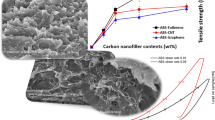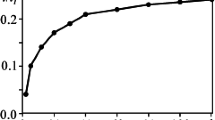Abstract
Nanocomposites of ethylene–propylene–diene monomer (EPDM)/styrene–butadiene rubber (SBR) (80/20) filled with different content of nanoclay 0–10 phr (parts per hundred rubber) were prepared on the two-roll mill. Tensile modulus was studied using composite theories. Transmission electron microscopy showed the existence of intercalated, aggregated, and partially exfoliated structures. The tensile modulus of nanocomposites was studied by the Guth, Halpin–Tsai, and modified Halpin–Tsai equation, which is generally used for composites reinforced through fiber-like or rod-like fillers. Composite models are mostly used in particulate-reinforced polymers, particularly in non-rigid polymer matrices. The aspect ratios of nanoclay platelets in nanocomposites were determined by statistically analyzing transmission electron micrographs. The modulus reduction factor is a vital role in the enhancement of predicted theoretical values of the tensile modulus. Taking account of the lower influence of the platelet-like filler to tensile modulus than the fiber-like filler, the modulus reduction factor for the platelet-like fillers of 0.66, determined by fitting experimental data, is introduced into the above three equations. Because of the necessity for the development and reduction of characterization of these materials for diverse applications, modeling of rubber-based nanocomposites has become a hot issue in recent years. Mechanical modeling of rubber nanocomposites is critical for studying Young's modulus using various composite theories. Moreover, the effect of nanoclay addition on tensile properties of EPDM/SBR–nanoclay composite was tested. Percentage increase in tensile strength and elongation at break are 80% and 27%, respectively.









Similar content being viewed by others
References
Pukanszky B (1990) Influence of interface interaction on the ultimate tensile properties of polymer composites. Composites 21:255–262
Vishvanathperumal S, Gopalakannan S (2019) Effects of the nanoclay and crosslinking systems on the mechanical properties of ethylene–propylene–diene monomer/styrene butadiene rubber blends nanocomposite. SILICON 11(1):117–135
Vishvanathperumal S, Anand G (2020) Effect of nanoclay/nanosilica on the mechanical properties, abrasion and swelling resistance of EPDM/SBR composites. SILICON 12:1925–1941
Giannelis EP (1996) Polymer layered silicate nanocomposites. Adv Mater 8:29–35
Vaia RA, Price G, Ruth PN, Nguyen HT, Lichtenhan J (1999) Polymer/layered silicate nanocomposites as high performance ablative materials. J Appl Clay Sci 15:67–92
Wu Y-P, Jia QX, Yu D-S, Zhang L-Q (2004) Modeling Young’s modulus of rubber–clay nanocomposites using composite theories. Polym Test 23:903–909
Ganter M, Gronski W, Semke H, Zilg T, Thomann C, Muhlhaupt R (2001) Surface compatibilized layered silicates-a novel class of nanofillers for rubbers with improved mechanical properties. Kautsch Gummi Kunstst 54:166–171
Hanifpour A, Bahri-Laleh N, Mirmohammadi SA (2018) Silica-grafted poly1-hexene: A new approach to prepare polyethylene/silica nanocomposites. Polym Compos 40:1053–1060
Mirmohammadi SA, Nekoomanesh-Haghighi M, Gezaz SM, Bahri-Laleh N (2016) Polybutadiene/polyhedral oligomeric silsesquioxane nanohybrid: investigation of various reactants in polyesterification reaction. Polym Int 65:516–525
Karamishamloo M, Mirmohammadi SA, Davachi SM (2020) Polyethylene glycol/polyhedral oligomeric silsesquioxane as an in situ photocrosslinkable polymeric nanohybrid. Polym Int 69:492–501
Hedayati F, Moshiri-Gomchi N, Assaran-Ghomi M, Sabahi S, Bahri-Laleh N, Mehdipour-Ataei S, Mokhtari-Aliabad J, Mirmohammadi SA (2019) Preparation and properties of enhanced nanocomposites based on PLA/PC blends reinforced with silica nanoparticles. Polym Adv Technol 31:566–573
Irani-Kolash E, Moshiri-Gomchi N, Talebi-Liasi A, Sabahi S, Bahri-Laleh N, Mehdipour-Ataei S (2020) Javad Mokhtari-Aliabad & Seyed Amin Mirmohammadi, Preparation of an enhanced nanohybrid alloy based on polylactic acid/polycarbonate/nanosilica. Plast Rubber Compos 49(6):263–270
Heinrich G, Klüppel M, Vilgis TA (2002) Reinforcement of elastomers. Curr Opin Solid State Mater Sci 6:195–203
Fornes TD, Paul DR (2003) Modeling properties of nylon 6/clay nanocomposites using composite theories. Polymer 44:4993–5013
Osman MA, Rupp JEP, Suter UW (2005) Tensile properties of polyethylene-layered silicate nanocomposites. Polymer 46:1653–1660
Loyens W, Jannasch P, Maurer FHJ (2005) Poly(ethylene oxide)/Laponite nanocomposites via melt-compounding: effect of clay modification and matrix molar mass. Polymer 46:915–928
Brune DA, Bicerano J (2002) Micromechanics of nanocomposites: comparison of tensile and compressive elastic moduli, and prediction of effects of incomplete exfoliation and imperfect alignment on modulus. Polymer 43:369–387
Wu Y-P, Jia Q-X, Yu D-S, Zhang L-Q (2003) Structure and properties of nitrile rubber (NBR)–clay nanocomposites by co-coagulating NBR latex and clay aqueous suspension. J Appl Polym Sci 89:3855–3858
Wu Y-P, Zhang L-Q, Wang Y-Q, Liang Y, Yu D-S (2001) Structure of carboxylated acrylonitrile-butadiene rubber (CNBR)–clay nanocomposites by co-coagulating rubber latex and clay aqueous suspension. J Appl Polym Sci 82:2842–2848
Vishvanathperumal S, Gopalakannan S (2017) Swelling properties, compression set behavior and abrasion resistance of ethylene-propylene-diene rubber/styrene butadiene rubber blend nanocomposites. Polymer Korea 41(3):433–442
Vishvanathperumal S, Navaneethakrishnan V, Gopalakannan S (2018) The effect of nanoclay and hybrid filler on curing characteristics, mechanical properties and swelling resistance of ethylene vinyl acetate/styrene butadiene rubber blend composite. J Adv Microsc Res 13(4):469–476
Shia D, Hui CY, Burnside SD, Giannelis EP (1998) An interface model for the prediction of young’s modulus of layered silicate elastomer nanocomposites. Polym Compos 19:608–617
Horsch S, Serhatkulu G, Gulari E, Kannan RM (2006) Supercritical CO2 dispersion of nanoclays and clay/polymer nanocomposites. Polymer 47:7485–7496
Moczo J, Pukanszky B (2008) Polymer micro and nanocomposites: Structure, interactions, properties. J Ind Eng Chem 14:535–563
Frankland SJV, Caglar A, Brenner DW, Griebel M (2002) Molecular simulation of the influence of chemical cross-links on the shear strength of carbon nanotube-polymer interfaces. J Phys Chem B 106:3046–3048
Frankland SJV, Harik VM, Odegard GM, Brenner DW, Gates TS (2003) The stress-strain behavior of polymer-nanotube composites from molecular dynamics simulation. Compos Sci Technol 63:1655–1661
Bradshaw RD, Fisher FT, Brinson LC (2003) Fiber waviness in nanotube-reinforced polymer composites—II: modeling via numerical approximation of the dilute strain concentration tensor. Compos Sci Technol 63:1705–1722
Fisher FT, Bradshaw RD, Brinson LC (2003) Fiber waviness in nanotube-reinforced polymer composites—I: modulus predictions using effective nanotube properties. Compos Sci Technol 63:1689–1703
Odegard GM, Frankland SJV, Gates TS (2003) The effect of chemical functionalization on mechanical properties of nanotube/polymer composites. In: 44th AIAA/ASME/ASCE/AHS/ASC Structures, Structural Dynamics, and Material Conference, Norfolk, VA, AlAA 2003–1701.
Odegard GM, Gates TS, Wise KE, Park C, Siochi E (2003) Constitutive modeling of nanotube–reinforced polymer composites. Compos Sci Technol 63:1671–1687
Sheng N, Boyce MC, Parks DM, Rutledge GC, Abes JI, Cohen RE (2004) Multiscale micro-mechanical modeling of polymer/clay nanocomposites and the effective clay particle. Polymer 45:487–506
Smith GD, Bedrov D, Li L, Byutner O (2002) A molecular dynamics simulation study of the viscoelastic properties of polymer nanocomposites. J Chem Phys 117:9478–9490
Brown D, Mele P, Marceau S, Alberola ND (2003) A molecular dynamics study of a model nanoparticle embedded in a polymer matrix. Macromolecules 36:1395–1406
Zhu L, Narh KA (2004) Numerical simulation of the tensile modulus of nanoclay-filled polymer composites. J Polym Sci Part B Polym Phys 42:2391–2406
Das S, Chattopadhyay S, Dhanania S, Bhowmick AK (2019) Reactive grafting of 3-octanoylthio-1-propyltriethoxysilane in styrene butadiene rubber: characterization and its effect on silica reinforced tire composites. Polymer 179:121693
Yuan Z, Li W, Li C, Ye L (2019) Construction of multiple crosslinking networks in EPDM rubber: synergistic reinforcing effect of graphene-zinc dimethacrylate on EPDM and improvement mechanism of sealing resilience. Compos A 121:254–264
Zirnstein B, Schulze D, Schartel B (2019) The impact of polyaniline in phosphorus flame retardant ethylene–propylene–diene-rubber (EPDM). Thermochim Acta 673:92–104
Sagar M, Nibedita K, Manohar N, Raj Kumar K, Suchismita S, Pradnyesh A, Babul Reddy A, Rotimi Sadiku E, Gupta UN, Lachit P, Jayaramudu J (2018) A potential utilization of end-of-life tyres as recycled carbon black in EPDM rubber. Waste Manag 74:110–122
Guth E (1945) Theory of filler reinforcement. J Appl Phys 16:20
Halpin JC, Kardos JL (1976) The Halpin-Tsai equations: a review. Polym Eng Sci 16:344–352
Halpin JC (1969) Stiffness and expansion estimates for oriented short fibers composites. J Compos Mater 3:732–734
Nielsen LE (1970) Generalized equation for elastic moduli of composite materials. J Appl Phys 41:4626–4627
Lewis TB, Nielsen LE (1970) Dynamic mechanical properties of particulate-filled composites. J Appl Polym Sci 14:1449–1471
Ahmed S, Jones FR (1990) A review of particulate reinforcement theories for polymer composites. J Mater Sci 25:4933–4943
Tjong SC (2006) Structural and mechanical properties of polymer nanocomposites. Mater Sci Eng R Rep 53:73–197
Einstein A (1956) Investigations on the theory of the Brownian movement. Dover, New York
Mooney M (1951) The viscosity of a concentrated suspension of spherical particles. J Colloid Sci 6:162–170
Brodnyan JG (1959) The concentration dependence of the Newtonian viscosity of prolate ellipsoids. Trans Soc Rheol 3:61–68
Broutman LJ, Krock RH (1967) Modern composite materials. Addison Wesley, Reading
Hirsch TJ (1962) Modulus of elasticity of concrete effected by elastic modulus of cement phase matrix and aggregate. J Am Concr Inst 59:427–452
Paul B (1960) Prediction of the elastic contents of multiphase materials. Trans Am Inst Min Metall Pet Eng 218:36–41
Counto UJ (1964) The effect of the elastic modulus of the aggregate on the elastic modulus, creep and creep recovery of concrete. Mag Concr Res 16:129–138
Hansen TC (1965) Influence of aggregate and voids on the modulus of elasticity of concrete. J Am Concr Inst 62:193–216
Kaplan MF (1959) Ultrasonic pulse velocity, dynamic modulus of elasticity, Poission’s ratio and the strength of concrete made with thirteen different coarse aggregates. In: RILEM Bull. (Paris), New Series No. 1, March 1959, 58
Guth E, Gold O (1938) On the hydrodynamical theory of the viscosity of suspensions. Phys Rev 53:322–325
Frogley MD, Ravich D, Wagner HD (2003) Mechanical properties of carbon nanoparticle-reinforced elastomers. Compos Sci Technol 63:1647–1654
Somoza AM, Tarazona P (1989) Density functional approximation for hard-body liquid crystals. J Chem Phys 91:517–527
Alipour A, Naderi G, Bakhshandeh GR, Vali H, Shokoohi SH (2011) Elastomer nanocomposites based on NR/EPDM/organoclay: morphology and properties. Int Polym Proc 26(1):48–55
Wu YP, Jia QX, Yu DS, Zhang LQ (2003) Structure and properties of nitrile rubber (NBR)–clay nanocomposites by co-coagulating NBR latex and clay aqueous suspension. J Appl Polym Sci 89(14):3855–3858
Balachandran M, Bhagawan SS (2012) Mechanical, thermal and transport properties of nitrile rubber (NBR)-nanoclay composites. J Polym Res 19:9809–9818
Munusamy Y, Ismail H, Mariatti M, Ratnam CT (2008) Ethylene vinyl acetate/natural rubber/organoclay nanocomposites: effect of sulfur and peroxide vulcanization. J Reinf Plast Compos 27:1925–1945
Jeon HS, Rameshwaram JK, Kim G (2004) Structure-property relationships in exfoliated polyisoprene/clay nanocomposites. J Polym Sci, Part B: Polym Phys 42:1000–1009
Fornes TD, Yoon PJ, Keskkula H, Paul DR (2001) Nylon 6 nanocomposites: the effect of matrix molecular weight. Polymer 42:9929–9940
Fornes TD, Yoon PJ, Keskkula H, Paul DR (2002) Erratum to “Nylon 6 nanocomposites: the effect of matrix molecular weight” [Polymer 42 (2001) 9929–40]. Polymer 43:2121–2122
Oberth AE (1967) Principle of strength reinforcement in filled rubbers. Rubber Chem Technol 40:1337–1363
Mohapatra AK, Mohanty S, Nayak SK (2011) Modeling of the mechanical properties of polylactic acid/clay nanocomposites using composite theories. Int J Plast Technol 15:174–187
Shimpi NG, Mishra S (2010) Synthesis of nanoparticles and its effect on properties of elastomeric nanocomposites. J Nanopart Res 12:2093–2099
Senthilvel K, Vishvanathperumal S, Prabu B (2016) L John Baruch, Studies on the morphology, cure characteristics and mechanical properties of acrylonitrile butadiene rubber with hybrid filler (carbon black/silica) composite. Polym Polym Compos 24(7):473–480
Vishvanathperumal S, Gopalakannan S (2016) Reinforcement of ethylene vinyl acetate with carbon black/silica hybrid filler composites. Appl Mech Mater 852:16–22
Vishvanathperumal S, Navaneethakrishnan V, Anand G, Gopalakannan S (2020) Evaluation of crosslink density using material constants of ethylene–propylene–diene monomer/styrene–butadiene rubber with different nanoclay loading: finite element analysis-simulation and experimental. Adv Sci Eng Med 12(5):632–642
Vishvanathperumal S, Anand G (2021) Effect of nanosilica and crosslinking system on the mechanical properties and swelling resistance of EPDM/SBR nanocomposites with and without TESPT. Silicon 13:3473–3497. https://doi.org/10.1007/s12633-020-00792-9
Ganeche PS, Balasubramanian P, Vishvanathperumal S (2021) Halloysite nanotubes (HNTs)-filled ethylene-propylene-diene monomer/styrene-butadiene rubber (EPDM/SBR) composites: mechanical, swelling, and morphological properties. SILICON. https://doi.org/10.1007/s12633-021-01410-y
Author information
Authors and Affiliations
Corresponding author
Ethics declarations
Conflict of interest
The authors also declare that there is no conflict of interest in this manuscript.
Additional information
Publisher's Note
Springer Nature remains neutral with regard to jurisdictional claims in published maps and institutional affiliations.
Rights and permissions
About this article
Cite this article
Ravi Theja, M.S., Kilari, N., Vishvanathperumal, S. et al. Modeling tensile modulus of nanoclay-filled ethylene–propylene–diene monomer/styrene–butadiene rubber using composite theories. J Rubber Res 24, 847–856 (2021). https://doi.org/10.1007/s42464-021-00140-5
Received:
Accepted:
Published:
Issue Date:
DOI: https://doi.org/10.1007/s42464-021-00140-5




